Question
Dairy cattle are kept for milk production. Approximately half of all the calves born are male.
(a) Sex is determined in cattle in exactly the same way as it is in humans.
Explain why 50% of all cattle are born male.
You may draw a genetic diagram to help your explanation.
…………………………………………………………………………………………………………………………………
…………………………………………………………………………………………………………………………………
…………………………………………………………………………………………………………………………………
…………………………………………………………………………………………………………………………………
……………………………………………………………………………………………………………………………..[4]
(b) Dairy farmers only need a very small number of male calves. They limit the number by
using sex selection. Sperm cells are identified and sorted before they are used in artificial
insemination (AI).
Explain how artificial insemination is carried out.
…………………………………………………………………………………………………………………………………
…………………………………………………………………………………………………………………………………
…………………………………………………………………………………………………………………………………
…………………………………………………………………………………………………………………………………
……………………………………………………………………………………………………………………………..[2]
(c) Table 2.1 shows the composition of 100 g of cow’s milk compared with the same quantities of
commercial formula milk and human milk.
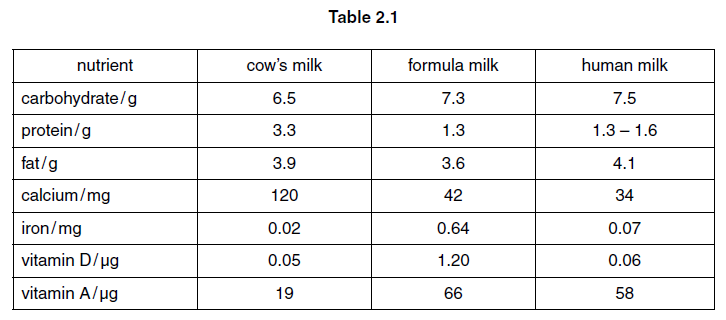
Some women do not breast-feed their babies but bottle-feed them using formula milk. Health
authorities advise against the use of cow’s milk until babies are about 9 months old.
Use the information in Table 2.1 to explain the advantages of using formula milk rather than
cow’s milk.
…………………………………………………………………………………………………………………………………
…………………………………………………………………………………………………………………………………
…………………………………………………………………………………………………………………………………
…………………………………………………………………………………………………………………………………
…………………………………………………………………………………………………………………………………
…………………………………………………………………………………………………………………………………
…………………………………………………………………………………………………………………………………
……………………………………………………………………………………………………………………………..[4]
One of the components of human milk is the enzyme lysozyme that is present in many body fluids
and is responsible for breaking down the cell walls of bacteria.
(d) Define the term enzyme.
…………………………………………………………………………………………………………………………………
…………………………………………………………………………………………………………………………………
…………………………………………………………………………………………………………………………………
……………………………………………………………………………………………………………………………..[2]
(e) The effect of human lysozyme on two common species of bacteria, A and B, was investigated
at two different values of pH.
The investigation was set up as shown in Fig. 2.1.
The test-tubes were kept at 37 °C for 24 hours.
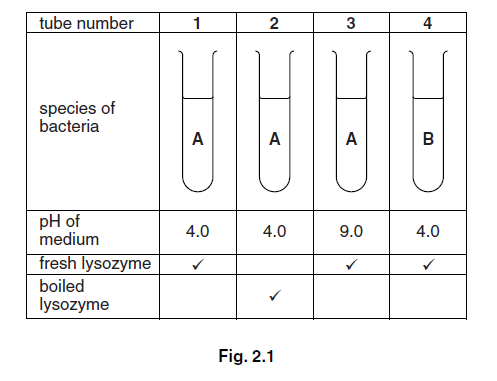
After 24 hours, samples were taken from each test-tube. Each sample was placed onto
nutrient agar in Petri dishes. The dishes were incubated at 28 °C for a further 24 hours to
allow any bacteria to grow.
The results are shown in Fig. 2.2.
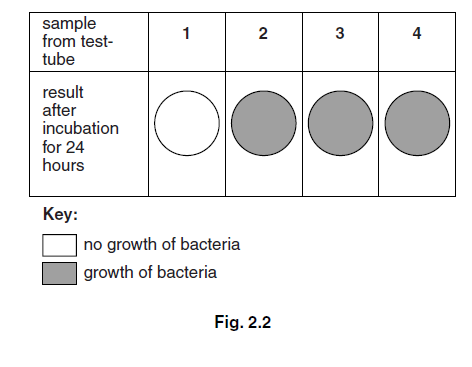
Explain the results shown in Fig. 2.2 by comparing the following pairs:
1 and 3 ……………………………………………………………………………………………………………………..
…………………………………………………………………………………………………………………………………
…………………………………………………………………………………………………………………………………
……………………………………………………………………………………………………………………………..[2]
1 and 4 ……………………………………………………………………………………………………………………..
…………………………………………………………………………………………………………………………………
…………………………………………………………………………………………………………………………………
……………………………………………………………………………………………………………………………..[2]
1 and 2 ……………………………………………………………………………………………………………………..
…………………………………………………………………………………………………………………………………
…………………………………………………………………………………………………………………………………
……………………………………………………………………………………………………………………………..[2]
(f) Human milk also contains antibodies. Explain the benefits of antibodies to a newborn child.
…………………………………………………………………………………………………………………………………
…………………………………………………………………………………………………………………………………
…………………………………………………………………………………………………………………………………
…………………………………………………………………………………………………………………………………
……………………………………………………………………………………………………………………………..[2]
Answer/Explanation
Ans:

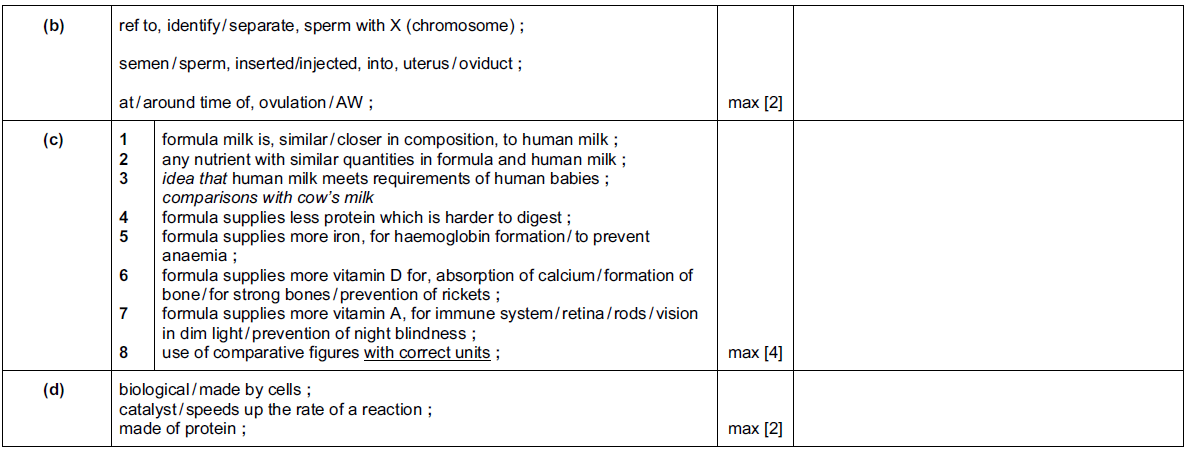
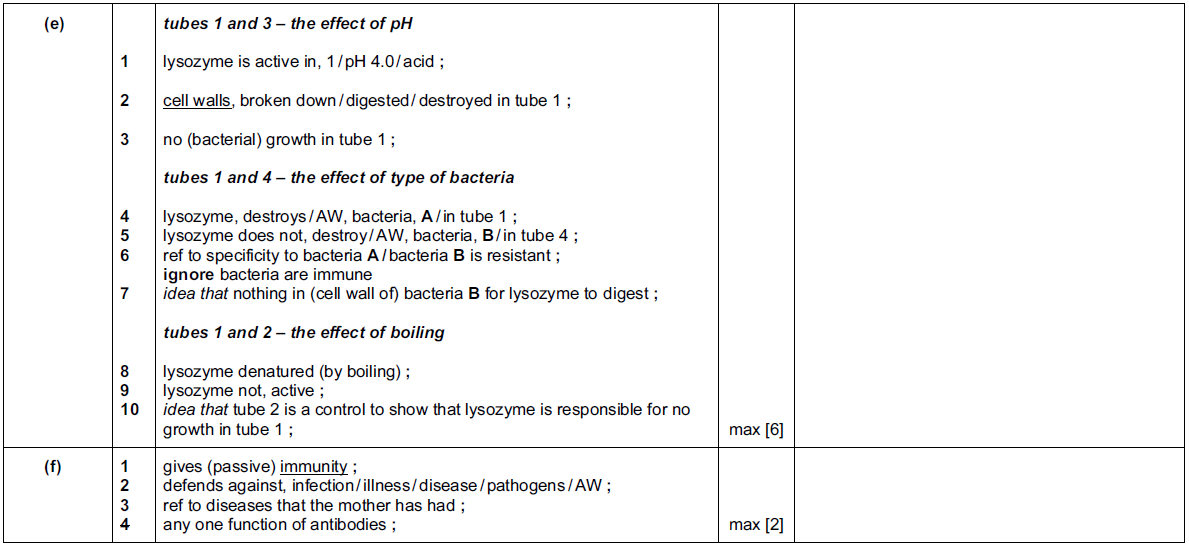
Question
(a) (i) Define the term chromosome. [2]
(ii) Fig. 6.1 shows a plant cell.
On Fig. 6.1, draw a line labelled W to show where chromosomes are found in this cell.
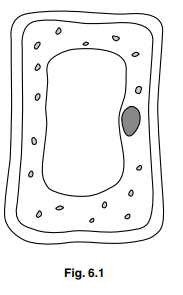
(b) In mice the allele for black fur (B) is dominant to the allele for white fur (b).
A mouse with black fur was mated with a mouse with white fur.
The mouse with black fur had the genotype Bb.
Complete Fig. 6.2 to show how fur colour is inherited by the offspring of this mating
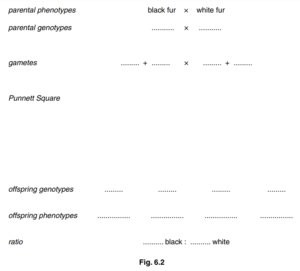
(c) Sex inheritance in mice is the same as in humans.
State the sex chromosomes of a male mouse and a female mouse.
male mouse ………….
female mouse ………….
Answer/Explanation
Ans
6 (a) (i) thread like structure/AW;
contains DNA;
carries genes / genetic information/ hereditary material;
(ii) line ending on the nucleus;
(b) parental genotypes: Bb x bb;
gametes: B + b x b + b;
F1 genotypes: Bb + bb + Bb + bb;
F1 phenotypes; black + white + black + white;
ratio: 1 black : 1 white;
(c) (male) XY;
(female) XX;
